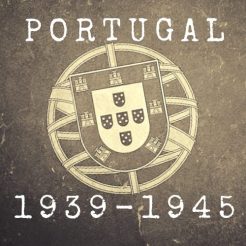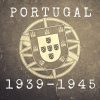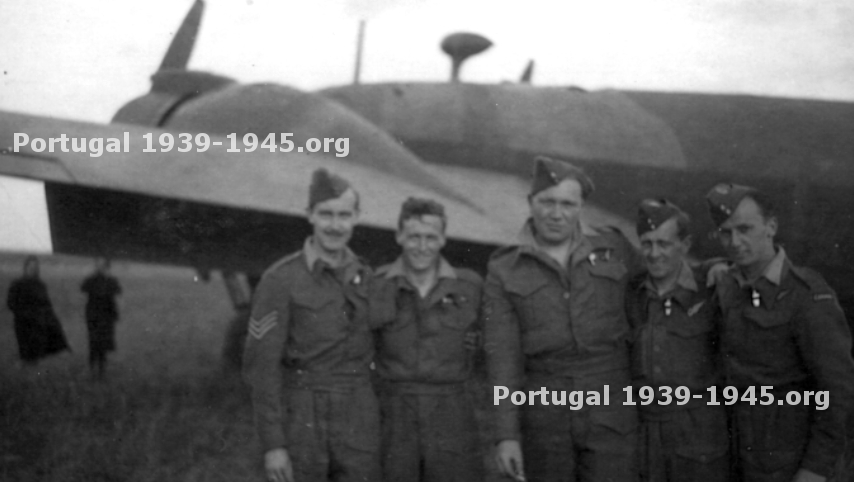
. .
The Wellington's crew in Sagres.
From left to right: Harry Heaps, W. Mclhinney, W. Buddle, Reg France e G. Hutchison
(Picture Nuno Silva)
Date 19-04-1943
Location Cape Saint Vicente - Algarve
Force RAF 1443FTF
Aircraft Vickers Wellington X HZ255
From-To Hurn (GB) → Gibraltar
Crew
. Sgt W. "Bill" Mclhinney Irl
. Sgt G. "Jim" Hutchison Canada
. Sgt Reg V. France GB
. Sgt Harry Heaps GB
. Sgt W. "Bill" Buddle GB
On April 19, 1943, the crew was in transit between England and North Africa when a severe storm over the Bay of Biscay, with headwinds and rain, increased the aircraft fuel consumption, and near the lighthouse of Saint Vicent Cape, in South Portugal, they had completely emptied the deposits.
The radio operator managed to establish contact with the Sagres Naval Station, where the Navy lieutenant, José dos Santos Arrobe, guided them to a relatively flat wheat field. The Wellington landed without any problems at 10.45 am, in the Val Santo area, both aircraft and crew completely unharmed. Harry Heaps, one of the airmen, told the Portuguese journalist Elisabete Rodrigues in 1987 that he believed they had been protected by a guardian angel.
The same journalist also spoke to Maria Júlia Arrobe, wife of Lieutenant Arrobe, one of the first persons to arrive near the plane, and she recalled that the British “seemed completely lost, having no idea where they were”.
Resources:
* “Aviões da Cruz de Cristo” – Mário Canongia Lopes
* Elisabte Rodrigues
* Letters from Harry Heaps
* Newspaper "London Times"
* Newspaper "Algarve Resident"
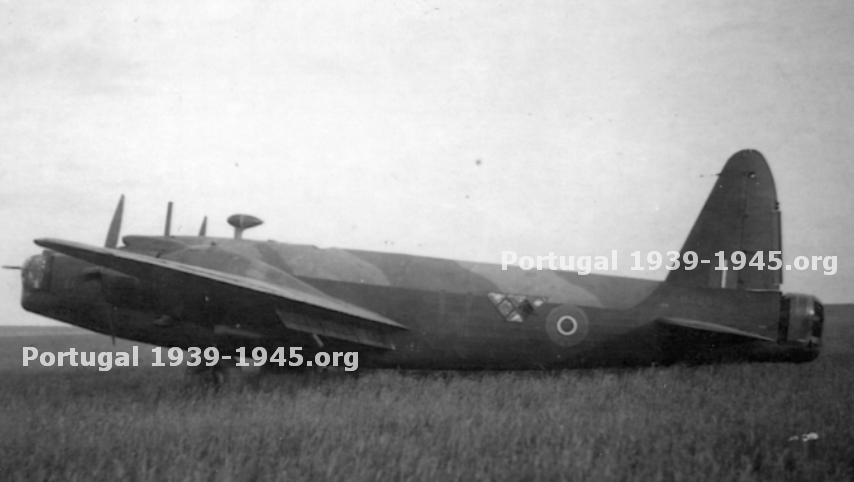
The Wellington HZ255 in Sagres
(Photo: Nuno Silva)
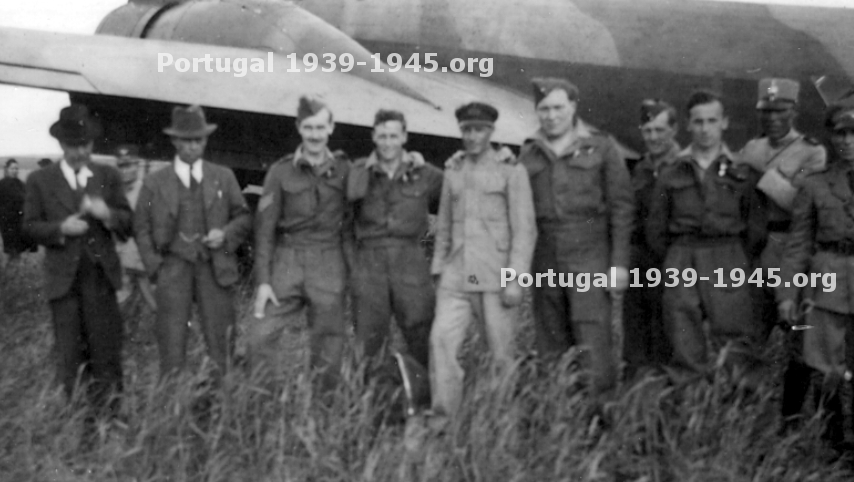
The crew and some locals with the plane
(Photo: Nuno Silva)
“They were about to set the plane on fire when my husband approached them explaining that they were in Portugal, in a neutral and friendly land. One of them bowed and kissed the ground with joy”, he added.
The men and the aircraft were surrounded by the curious population. The five men ended up being installed in the naval officer's house, where they ate eggs, bread, ham, fruit. After they took pictures near the house and he plane, before being sent to the only hotel in the area, the Zé Luis.
The next day they were escorted to Lagos where they met John Crowley, a former British journalist, who lived there. Days later, he sent a letter to a family member describing the “enthusiasm” with which the airmen were received in the city. The family member forwarded the letter to the “London Times”, which published it on May 12: “Lagos is a city where nothing ever happens, but this week we broke the rules, with everyone excited by the presence of five British aviators”, he explained.
They installed themselves in "the only hotel" in town, and when Crowley took them to the beach, the ride was like "a triumphal procession." “They were followed by an sheering crowd, all the women of Lagos seem to have appeared at the windows and balconies, the men shouted greetings and one of them went up to an aviator, greeted him and said proudly – Glad to meet you; won´t you sit down? - A phrase that he had evidently heard repeatedly in the movies”, he writes.
In a cafe where they went after lunch, there were no seats left and people had no place even stand up. “Minutes after we had sat down, a young man appeared, with a bottle of port wine and a card, saying that it was to be drunk in honor of the victory of the Allies. A quarter of an hour later five more bottles appeared (one for each of them) with similar wishes”, continued the former journalist. The café bill was paid by “a local priest”.
On that day, they were invited to a ball, organized in their honor, which counted with the presence of the most important personalities of the land, says Elisabete Rodrigues. A woman who remembered that day explained, on condition of anonymity, that “they were young boys and they looked very handsome in their uniforms, true heroes”. “We were young and we spent the dance telling them in Portuguese – I love you – but they didn't understand anything”, she confesses.
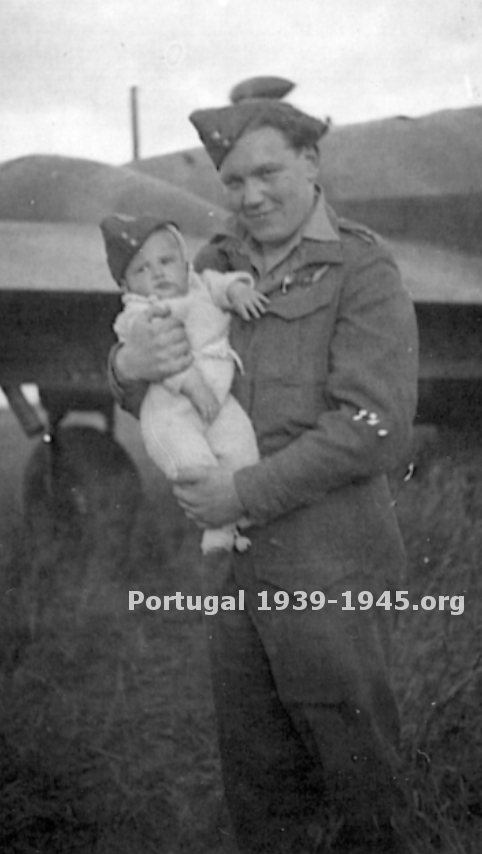
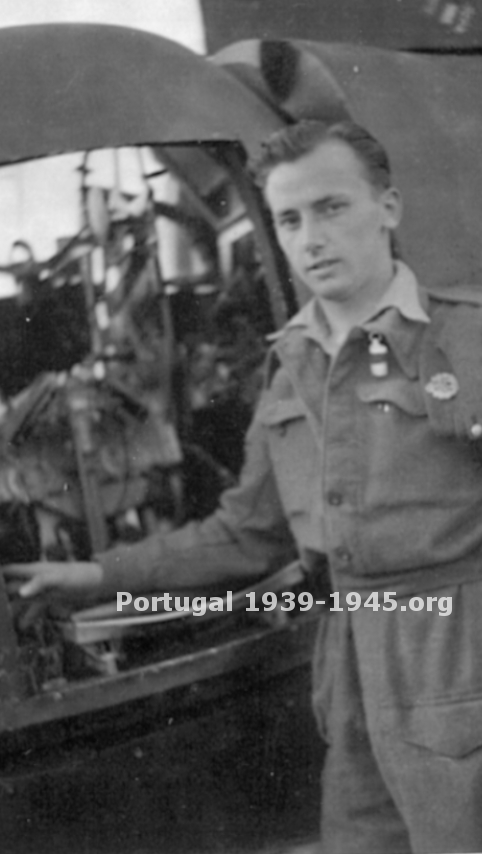
On the left: Sargeant wireless operator Bill Buddle with a baby in Sagres.
On the right: Sargeant Gunner Jim Huchinson.
(Photos: Nuno Silva)
The airmen promised that they would fly over Sagres as soon as the war was over. Maria Arrobe mentions in her interview that “a fortnight after the end of the war a foreign plane flew in circles over Saint Vicente Cape and Sagres. I always believed they were on board of it.”
The five crew members were interned with other Allied airmen in Elvas, a southeastern border town where they arrived on April 23. On June 23, 1943, they were repatriated.
Meanwhile, the aircraft was inspected on April 22 by a Portuguese pilot who concluded that there were conditions to fly it to Air Base No. 2, but during take-off, and when the plane was speeding at 130 kilometers per hour, a tire burst resulted in damages to the landing gear and one of the propellers.
As the mischief made air removal impossible, the Army was asked to mobilize two or three Chevrolet-Thornton trucks to carry the airframe to one of the Military Air Force bases. On April 26, vehicles and specialized personnel were sent for dismantling and transport operations.
At the beginning of 1988, this event caused an renewed uproar in South Portugal when Harry Heaps published in the newspapers "Tribuna do Algarve" and "Algarve News" (in English) a request for help. He was preparing a trip to Portugal, with his wife , to remember his time spent in Sagres, Lagos and Elvas, with the four members of his crew and asking to publicize it, if possible.
A commission was created with the aim of giving VIP treatment to the visitor and honoring other fighters who had lost their lives during the war in the Algarve area. In the plans was a trip to the cemetery of Sagres where two Catalina crew members rest since 1943. Banquets and other visits to special places were also prepared for May 1989 but, fifteen days before the trip, the emotion was too much for Harry Heaps who died due to a heart attack.
Carlos Guerreiro
